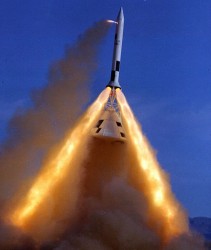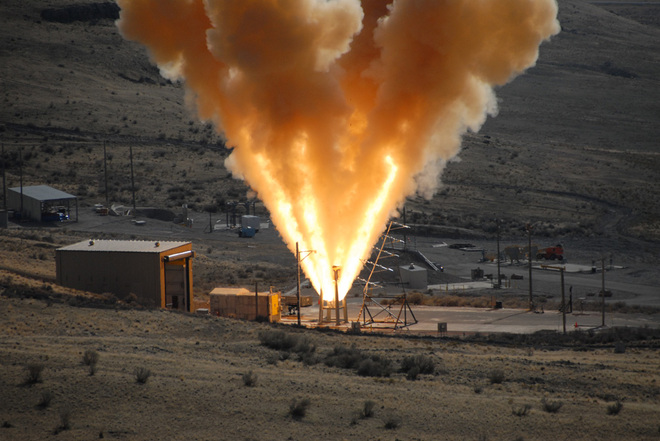[/caption]When the Constellation Program is completed, we’ll have a brand new generation of rocket design (Ares) and a hi-tech space ship (Orion). It only seems fair that we should also have a new kind of emergency mechanism that will carry the crew to safety should a problem during launch threaten the astronauts.
Enter the Constellation Launch Abort System, delivering a million pounds of thrust, carrying the crew a mile from any danger. Looks like it would be one hell of a ride!
Last July, I reported that the first full-scale test firing of the Orion jettison motor was successful, and it would seem the tests are continuing. Lighting up the Utah landscape, the awesome power of the Launch Abort System is abundantly clear and it looks like we are well on the road to the full-scale launch abort mock-up.
See the Orion launch abort motor in action »

The Constellation safety measure can be used should there be an emergency on the launch pad or as the Ares I blasts through the atmosphere. Although the experience would be a violent one (the G-force will be several times that of a normal shuttle launch), at least the crew will be carried to safety.
Source: Wired


Quote: “the G-force will be several times that of a normal shuttle launch”
Hmm, I thought the G-force at the launch is already pretty harsh, so I wonder if the several times higher values will not kill the crew as safely as the crash alone. Well, probably not, I assume they know what they do, but I think anyway that the claim that it will bring them to safety is exaggerated – I may be wrong but I would tell that there is still high chance they die or suffer severe injuries during the jettison. Surely still better than a sure death in the crash, but one should not expect miracles from such system.
If I remember right launch is only 4 or 5 G’s. That is tough but not too bad. Jet pilots get that a lot. Short term blasts like this produce much higher G’s but for only a matter of seconds or less. I personally have gone through 11 g’s on a ejection seat test device at Warminster. That happens to be so short it is over before you know what hit you. The g forces the astronauts might be even more. Even enough to cause black out but not enough to have detrimental effects. Specially since they are in reclining G-force designed seats.
Still we wish them “God Speed”
Shuttle launches normally pull no more than 3 gees. That was part of the original design criteria, as almos anyone can handle that much, so crews ned not be exceptionally healthy test/fighter pilot stuff.
Some of the shuttle launch abort modes (which pretty much don’t exist until SRB burnout and separation) as well as military ejection at high speed has been described as ‘attempted suicide to avoid certain death.’
Interestingly, only the Russians have had real experience with such things, mostily a launcher that caught fire on the pad and gulfed the stack before the launch escape system could be used. (Ground control wiring had been burned away, and it took precious seconds for a radio link to be used.) But other than a short, nasty ride, the crew walked away after landing….
the g’s experienced in a launch arent the same as fighter pilot g’s. Pilots experience the G force in the y axis, as in, the head to feet axis, which strains their heart as it has to pump against gravity to get blood to the head…
Launch G’s are experienced in the x axis, so they are the same kind u would experience in a car when u accelerate… this kind of G is not nearly as tough on the body as the pilot kind, as it does not strain the heart or anything like that… in fact, the most fragile organ with regard to G in this scale (mainly deceleration but perhaps also in acceleration) are the Eyes as the capillaries can blow up due to the extreme blood pressure. However; i reckon that all the astronauts will experience is sore buttocks simply from being pushed into the seat so hard ;P
Where do we sign up for manned tests?
Actually this test was for the abort motor – which is being developed by ATK in Utah. The previous test was of the jettison motor – being developed by Aerojet in Sacramento, CA. The difference is that the jettison motor pulls the tower and the cover off on every flight that does NOT require an abort. The abort motor pulls off the Orion capsule in an actual abort.